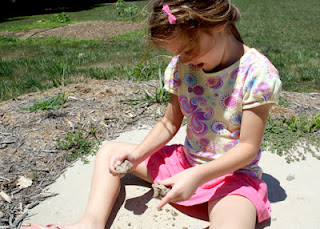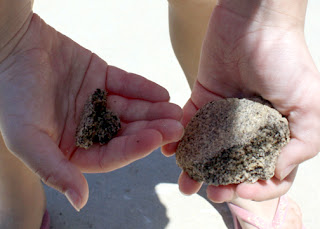For this week's hands-on activity from Evan-Moor
Everyday Literacy: Science, Tessa simulated the effects of weather on
mock rocks. I formed the
rocks from a mixture of coffee, coffee grounds, flour and salt ahead of time.
 |
| The coffee mixture made pretty convincing rocks. After a full day of basking in the sun, they dried nearly, well, as hard as rocks! |
First, Tessa rubbed sandpaper over a
rock to simulate wind blowing grains of sand against large rocks.
 |
| Tessa rubbed sandpaper over a mock rock. |
Next, she placed a
rock in a jar of water and shook it to simulate waves crashing against a cliff.
 |
| After shaking a rock in a jar of water, Tessa checked for changes. |
Finally, Tessa dropped and hit rocks together to see what would happen.
 |
| Tessa learned that when large rocks collide, they break into smaller rocks. In time, those smaller rocks turn into sand or soil. |
 |
| A close-up of one of Tessa's changed rocks. |
Tessa and I both greatly enjoyed this experiment. It well-suited her age and cemented in her mind the various ways rocks are changed by natural forces.






No comments:
Post a Comment